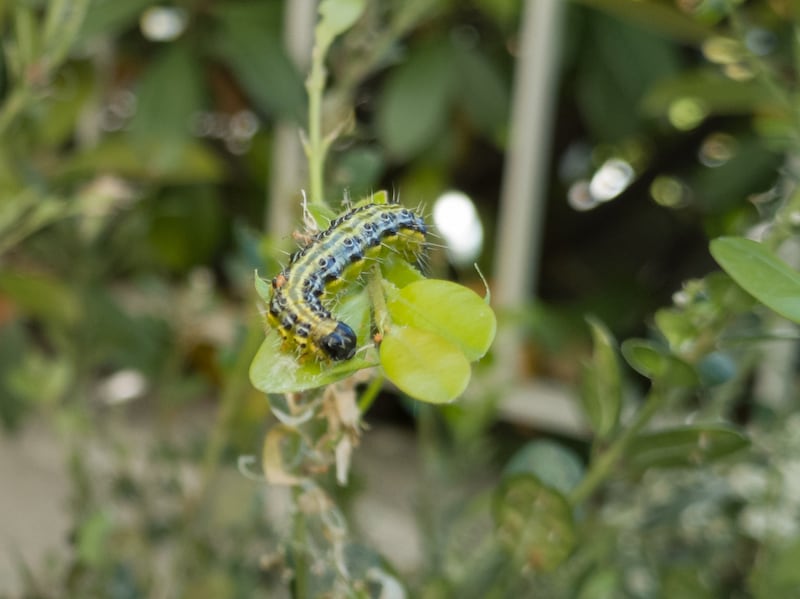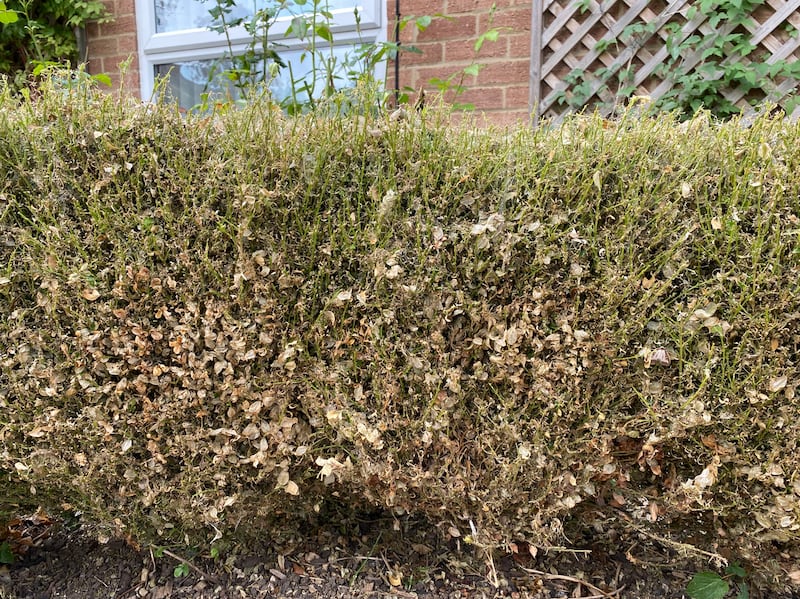Q: I have box hedges in the front and back garden of my house. Last year I noticed that they were attacked by the box tree moth caterpillar. The damage was noticeable but the hedges recovered well enough. This year the damage is much worse and other gardens in the area are affected, some hedges being totally stripped of leaves. Is it time to give up on the hedges or can they recover without using pesticides? CF, Co Dublin
A: As a long-time admirer of box hedging, I feel your pain. Despite the threat of various new pests and diseases in recent decades, this slow-growing, hardy evergreen shrub has been a mainstay of ornamental gardens around the world for centuries – just think of the formal gardens of Versailles – and remains unequalled in terms of its year-round good looks, versatility and ability to tolerate hard clipping and training.
Native to Asia, but a relatively recent arrival in Ireland, the first recorded evidence of box moth (Cydalima persimilis) in Europe was in 2007, and the first recorded evidence of it in Ireland was in Dublin in 2018. A very destructive pest of box hedging and box topiary, its large lime-green and black caterpillars overwinter in weblike cocoons concealed within the plant before emerging in spring to feed voraciously on the foliage and stems.
These quickly become adult moths that fly off in search of nearby host box plants on which to lay their yellow eggs, and so the life cycle continues, with new colonies subsequently appearing in nearby gardens. Badly infested plants can potentially be completely defoliated within a few weeks, seriously weakening and eventually killing them.
RM Block
Conventional insecticide controls are damaging to the environment and not terribly effective. But organically acceptable modern biological controls in the form of specific nematodes are very effective, just so long as their use is well timed. I say well-timed because the most important thing to remember about any form of nematode control is that it’s not preventative. So, as strange as it sounds, it won’t work unless the host pest in question is already present in sufficient numbers.


It’s also important to point out that in an urban environment like yours, where you’re closely surrounded by other gardens with box hedges or box topiary also potentially infested with box moth, complete eradication isn’t realistically achievable. Instead, the gloomy truth is that your plants remain at risk of being reinfected by moths visiting from other gardens. But you can do a huge amount to effectively minimise the damage.
If you have the stomach for it, then handpicking the caterpillars and disposing of them can also help
What’s essential to successful control is carefully monitoring your hedging for early signs of infestation. Once you see signs of the small caterpillars (these typically emerge in spring with plants at risk from March to October), then it’s crucial to act quickly to treat afflicted plants with a liquid spray of nematodes applied generously to the leaves. This needs to be done on a cloudy, humid but dry day to ensure it’s as effective as possible, and then reapplied a week later, making sure to thoroughly drench the plant.
[ Fionnuala Fallon: The best way to beat weeds and pests in the gardenOpens in new window ]
Many experts also recommend using pheromone moth traps (these are species-specific so will only attract box moths) to capture the adult male moths as they take to the wing in April. This is another way of disrupting this destructive pest’s life cycle, and is also a very useful way of anticipating the emergence of the caterpillars roughly two weeks later.


Bear in mind that nematode control is species-specific. For box moth, the UK’s Royal Horticultural Society (RHS) recommends the use of the nematode known as Steinernema carpocapsae (available to order from mrmiddleton.com as ‘Nemasys Fruit & Veg’), while the nematode known as Bacillus Thuringiensis, subspecies Aizawai, is also very effective (along with moth traps, this is available to order from top.buxus.com as “Xen Tari”).
If you have the stomach for it, then handpicking the caterpillars and disposing of them can also help, although it definitely comes with a serious ick factor and will be slow work. Good garden hygiene and a long-term maintenance schedule that builds soil health and plant vigour and resilience with the use of organic mulches, slow-release organic fertilisers and liquid foliar feeds such as TopBuxus, or liquid seaweed, will also do a lot to help keep your plants healthy and happy.





















